

In more technical terms, it is a process used to train behaviour, where reinforcement is used to strengthen and increase the probability of the behaviour; and punishment is used to weaken and decrease the probability of the behaviour.
Reinforcement and Punishment to Parents. Reinforcement Vs. Punishment for Kids (And Examples)
As they grow, our children learn which behaviors are acceptable and which are not.
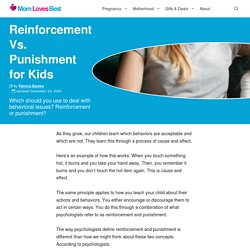
They learn this through a process of cause and effect. Here’s an example of how this works: When you touch something hot, it burns and you take your hand away. Then, you remember it burns and you don’t touch the hot item again. This is cause and effect. 8.2 Changing Behaviour through Reinforcement and Punishment: Operant Conditioning – Introduction to Psychology – 1st Canadian Edition. Learning Objectives Outline the principles of operant conditioning.Explain how learning can be shaped through the use of reinforcement schedules and secondary reinforcers. In classical conditioning the organism learns to associate new stimuli with natural biological responses such as salivation or fear. The organism does not learn something new but rather begins to perform an existing behaviour in the presence of a new signal. Operant conditioning, on the other hand, is learning that occurs based on the consequences of behaviour and can involve the learning of new actions.
12 Examples of Positive Punishment & Negative Reinforcement. You might be thinking that “positive punishment” sounds like an oxymoron, after all, how can punishment be positive?

Not many people “like” punishment, right? The disconnect in understanding this concept comes from the usage of the word “positive;” here at PositivePsychology.com, we generally use the term “positive” to refer to things that are inherently good, things that are life-giving, and things that promote thriving and flourishing. The concept of positive punishment comes from a very different era and a very different perspective on psychology; namely, the 1930s and behaviorism.
So, what actually is positive punishment and how does it relate to parenting, teaching, and even the workplace? Reinforcement and Punishment. Learning Objectives Explain the difference between reinforcement and punishment (including positive and negative reinforcement and positive and negative punishment)Define shapingDifferentiate between primary and secondary reinforcers In discussing operant conditioning, we use several everyday words—positive, negative, reinforcement, and punishment—in a specialized manner.
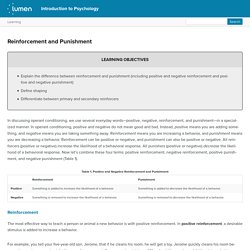
In operant conditioning, positive and negative do not mean good and bad. Positive vs. Negative Reinforcement: A Guide for Parents – Generation Mindful. I almost stopped bringing them to the playground.
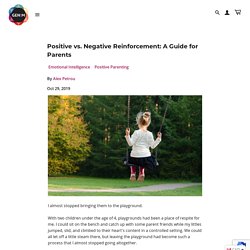
With two children under the age of 4, playgrounds had been a place of respite for me. I could sit on the bench and catch up with some parent friends while my littles jumped, slid, and climbed to their heart's content in a controlled setting. We could all let off a little steam there, but leaving the playground had become such a process that I almost stopped going altogether. Inevitably, when I announced it was time to go, my 3-year-old would run away. Laughing maniacally, he’d climb a slide or shimmy to the top of a play structure and gleefully gaze down at me as though it was a joke, as though dinner didn’t need to be made and naps didn’t need to happen.
Negative Reinforcement and Operant Conditioning. Did you know that parents could train their children to act defiant?

“Who in their right minds would do that?” You may wonder. Well, many of us actually do. Find out how a lot of parents unknowingly train their children in rebellion using negative reinforcement. Reinforcement and Punishment - How to Approach These Concepts in ABA Parent Training — ABA Parent Training: Curriculum, CEUs, Support, & More. As behavior analysts, we understand what the terms “reinforcement” and “punishment” mean in the field of applied behavior analysis.
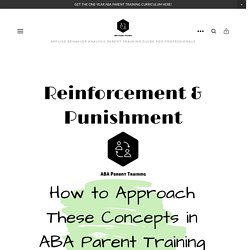
We know that reinforcement refers to the idea that a behavior increases in frequency after the presentation or removal of a stimulus follows that behavior. Reinforcement can be further defined by whether it is positive or negative reinforcement. Reinforcement vs. Punishment: Changing Behavior. Being a parent has been known as the best thing ever BUT also the most challenging endeavor you will encounter in your lifetime.
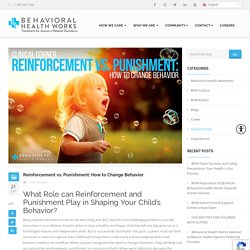
Parents strive to raise a healthy and happy child that will one day grow up as a full-fledged mature and independent adult. But to successfully accomplish this goal, a parent must set forth structure or rules throughout their childhood to help them understand and be realigned when their behavior needs to be modified. When a parent recognizes the need to change a behavior, they will likely end up using either reinforcement, punishment, or a mixture of both. Parenting Children with Positive Reinforcement (Examples + Charts) Children don’t come with instructions and discipline is often experienced by parents and children alike as an arena where our will and wits are tested.

Positive reinforcement is only one of many forms of discipline, but from the perspective of positive psychology, it may as well be the most important one as it focuses on amplifying what is already good in our children and in ourselves as their caretakers. Positive reinforcement as a form of positive discipline allows us to tap into our children’s individual strengths, draw attention to their personality traits and interests, and as a result give us an opportunity to connect, communicate effectively, and ultimately empower them to be more of themselves. Before you read on, we thought you might like to download our 3 Positive Psychology Exercises for free.
You can download the free PDF here. A Look at Parenting with Positive Reinforcement. Discipline strategies for teenagers. Teenage discipline: the basics Discipline isn’t about punishment.

It’s about teaching children appropriate ways to behave. For teenagers, discipline is about agreeing on and setting appropriate limits and helping them behave within those limits. Using Positive Reinforcement to Improve Behavior. When your child misbehaves, rewards might be the last thing on your mind.
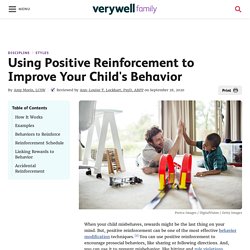
But, positive reinforcement can be one of the most effective behavior modification techniques.1 You can use positive reinforcement to encourage prosocial behaviors, like sharing or following directions. And, you can use it to prevent misbehavior, like hitting and rule violations. Positive reinforcement can also be an effective way to encourage and motivate your child to be responsible, do their chores, get along with their siblings, or complete their homework assignments without arguing. How Positive Reinforcement Works. Operant Conditioning. Learning: Negative Reinforcement vs. Punishment. Skinner’s Operant Conditioning: Rewards & Punishments. Operant Conditioning Explained.